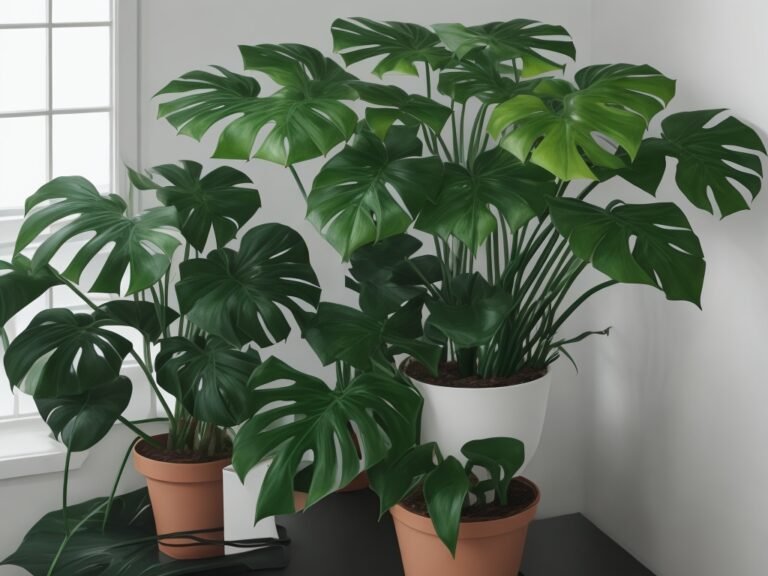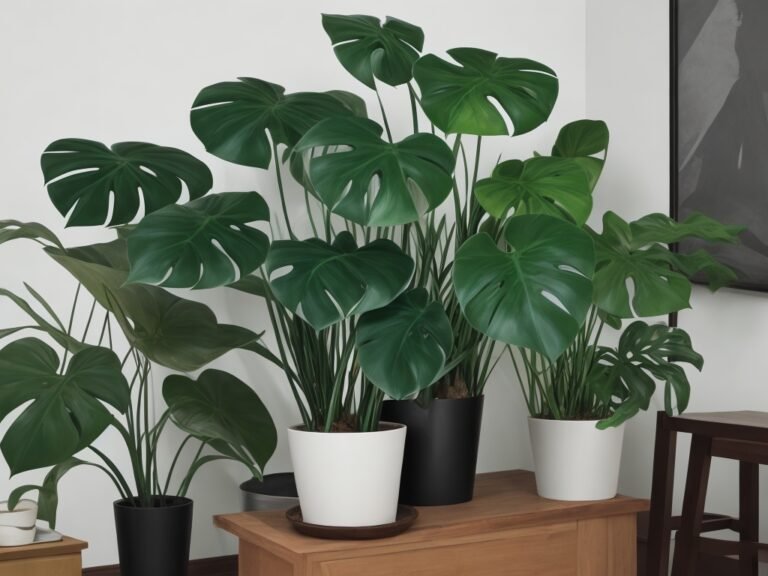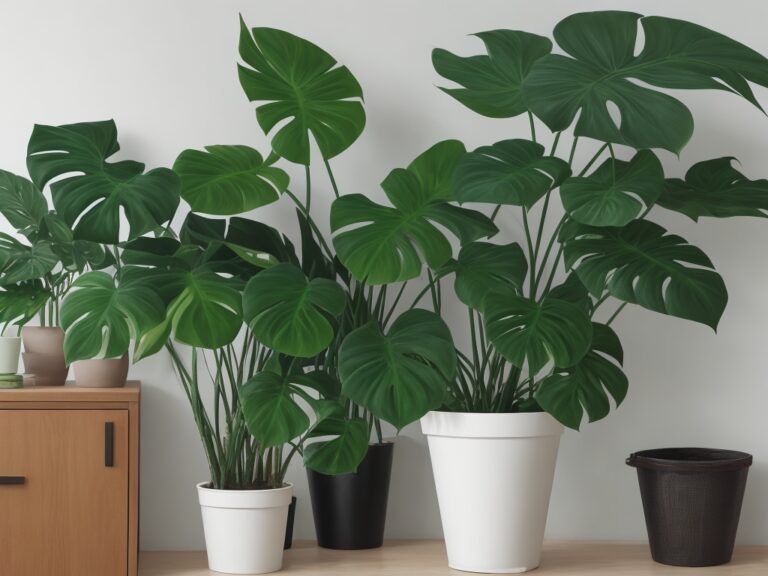Watering Monstera: Tips for Healthy Growth
Monstera plants are known for their beautiful foliage and are becoming increasingly popular among plant enthusiasts. However, caring for these plants can be tricky, particularly when it comes to watering them.
Watering is essential to the growth of Monstera plants, but improper watering can have serious consequences on their health. In this blog post, we will explore the importance of proper watering for your Monstera plant’s healthy growth.
We will cover how to determine your Monstera’s watering needs based on factors such as humidity and light, and how to recognize signs of overwatering or underwatering.
Lastly, we will provide you with tips on different techniques for watering your Monstera plants, including seasonal adjustments in watering methods.
Read on to learn everything you need to know about watering your Monstera plant for healthy growth!
Importance of Proper Watering for Monstera Plants
Proper watering is crucial for the growth and health of monstera plants. It ensures that the plant receives the necessary moisture and nutrients for its well-being. Consistent watering is important as it helps prevent issues like root rot and fungal growth.
Adequate watering also supports the growth of new leaves and foliage, contributing to a lush and beautiful plant. Understanding the specific watering needs of monstera plants is essential in maintaining their overall health and vitality.
So, when it comes to watering monstera plants, it’s important to strike the right balance.
Role of Water in Monstera Growth
Water plays a vital role in the growth and development of monstera plants. It transports nutrients and minerals to the roots, leaves, and stems of the plant, enabling photosynthesis and energy production for growth.
Adequate water intake ensures the plant’s cells remain turgid, providing structural support. Without water, the monstera plant would not be able to survive and thrive.
So, it is important to understand the watering needs of this tropical plant.
By providing the right amount of water, whether it’s on the forest floor or in large containers for indoor plants, you can help your Monstera deliciosa or Monstera adansonii thrive and become a beautiful addition to your houseplant collection.
Consequences of Improper Watering
Improper watering of Monstera houseplants can have detrimental effects on their health and growth. Overwatering can lead to root rot, fungal growth, and waterlogging, which can harm the plant.
On the other hand, underwatering can cause wilting, nutrient deficiencies, and hindered growth. Inconsistent watering can result in stress for the plant, affecting its overall well-being.
Additionally, improper watering can lead to the death of aerial roots, hampering natural growth. It is crucial to understand and avoid these consequences to ensure the long-term health of your Monstera plants.

Determining the Watering Needs of Your Monstera
Several factors come into play when determining the watering needs of your Monstera plant. The size of the plant, the environment it’s in, and the current season all contribute to its water requirements.
By observing the moisture level of the soil, you can gauge when it’s time to water your Monstera.
Using a moisture meter ensures accuracy in measuring soil moisture, guaranteeing that your plant receives the right amount of water. Additionally, understanding the natural habitat of Monstera plants, which typically thrive in tropical conditions, can guide your watering practices.
Adjusting the frequency of watering based on the growth season is also crucial for optimal growth.
Factors Influencing Water Intake
The size of the monstera plant and the root system play a crucial role in determining its water intake. Environmental conditions, such as temperature and humidity, also influence the plant’s water requirements.
Indoor monstera plants generally need less water compared to their outdoor counterparts, as indoor conditions tend to be drier. The presence of drainage holes in the plant’s container is important as it allows excess water to escape, preventing waterlogging.
Understanding these factors is essential for ensuring that the monstera plant receives the right amount of water to thrive.
Recognizing Signs of Overwatering and Underwatering
Overwatering can be identified by the presence of soggy soil, fungus growth, and waterlogged roots.
On the other hand, underwatering can be recognized through dry soil, wilting foliage, and nutrient deficiencies. Some common signs of overwatering include yellowing leaves, root rot, and fungal infections.
Conversely, drooping leaves, dry soil, and plant dehydration indicate underwatering. It is crucial to recognize these signs to adjust watering practices accordingly and ensure the healthy growth of your Monstera houseplants.
Techniques for Watering Monstera Plants
When it comes to watering Monstera plants, there are two main techniques to consider: top watering and bottom watering. The top watering method involves directly watering the Monstera plant over the soil, ensuring that the water reaches the roots.
On the other hand, bottom watering entails placing the Monstera plant in water and allowing the roots to absorb moisture from the bottom of the container. The best watering method for your Monstera plant depends on factors such as the root system, type of container, and personal preference.
Both techniques can be effective, as long as the plant receives the necessary moisture without becoming waterlogged. If you’re unsure which method to choose, it can be helpful to experiment with different watering techniques to determine what works best for your Monstera plant.
Top Watering Method
When it comes to watering your Monstera houseplants, the top watering method is a popular choice. This method involves pouring water over the soil, ensuring that the root system of the Monstera plant is adequately moistened.
To ensure healthy growth, it’s important to water your Monstera slowly, allowing the soil to gradually absorb the water. When using the top watering method, direct the water to the base of the plant, avoiding the foliage. This helps prevent fungal growth and waterlogging.
By utilizing the top watering method, you can ensure that the water reaches the roots, providing your Monstera plant with the necessary moisture for its overall health. Adapting this method based on your plant’s specific watering needs is crucial.
Bottom Watering Method
The bottom watering method for Monstera houseplants involves placing the plant in water, allowing the roots to absorb moisture from the bottom of the container. This technique is especially beneficial for plants with large root systems, as it ensures that the roots receive adequate hydration.
Unlike top watering, bottom watering helps prevent waterlogging, as excess water can easily drain out of the container. However, it is important to monitor the moisture level of the soil when using this method to avoid overwatering.
Adjusting the duration of the plant’s exposure to water during the bottom watering process helps maintain optimal moisture levels and prevents overwatering.
Seasonal Adjustments in Monstera Watering
Understanding the seasonal changes in watering is crucial for the growth and health of monstera plants.
During the growing season, these tropical plants, also known as the Swiss cheese plant, like Monstera deliciosa and Monstera adansonii, require more water as they are actively growing and transpiring moisture. In contrast, during the winter months, their growth slows down, and the soil takes longer to dry out, so they may need less water.
Adjusting the watering frequency and amount based on the season helps prevent overwatering or underwatering. By monitoring soil moisture and the plant’s health, you can make watering adjustments for optimal growth.
Watering Monstera in Summer
To ensure the healthy growth of your monstera plants during the summer months, it’s important to adjust the watering frequency based on temperature and humidity.
Monitor the soil moisture regularly to prevent both overwatering and dry soil conditions. Additionally, provide indirect light to avoid root rot and fungal growth.
When watering, use room-temperature tap water to prevent shocking the plant. It’s also crucial to ensure that the pots have drainage holes to prevent waterlogging.
By following these tips, you can ensure that your monstera plants thrive during the summer season.
Watering Monstera in Winter
During the winter months, it is important to adjust the watering frequency for your Monstera plants. Reduce the frequency of watering and allow the soil to dry slightly between waterings, but make sure it doesn’t completely dry out. Providing indirect light can help maintain the moisture level of the soil.

Be cautious not to overwater, as Monstera plants require less water during this time. Consider using a moisture meter to determine the watering needs of your plant. By following these tips, you can ensure that your Monstera thrives even in the winter months.
How Humidity and Light Affect Monstera’s Water Requirements?
Humidity and light have a significant impact on the water needs of Monstera plants. Higher humidity levels in the room can decrease watering frequency, while indirect light helps maintain soil moisture. Bright, direct sunlight can increase water consumption.
Understanding Monstera’s natural habitat in Central America provides insights into its water requirements.
Understanding the Role of Humidity
Monstera plants, also known as Swiss cheese plants, thrive in humid conditions, similar to their natural habitat in southern Mexico and Panama.
High humidity levels play a crucial role in promoting healthy foliage growth in these tropical plants. Dry indoor conditions can lead to nutrient deficiencies and dry soil, impacting the overall health of the monstera plant.
To increase humidity, consider using a humidifier, placing the plant on a pebble tray filled with water, or misting the leaves regularly. Maintaining room humidity between 60-70% is ideal for the optimal growth and well-being of monstera plants.
Effects of Light on Water Consumption
Light intensity has a significant impact on the water requirements of monstera plants. Bright, indirect light promotes growth and increases water consumption, while low light conditions reduce the plant’s water needs.
It is important to avoid exposing monstera plants to direct sunlight, as it can dry out the soil quickly.
To ensure optimal watering, adjust the watering frequency based on the amount of light the plant receives. By understanding the effects of light on water consumption, you can provide your monstera plant with the ideal conditions for healthy growth.
Conclusion
Proper watering is crucial for the healthy growth of your Monstera plants. Water plays a significant role in supporting their growth and providing essential nutrients.
However, improper watering can have adverse effects on your plant’s health. To determine the watering needs of your Monstera, you must consider factors such as humidity, light, and seasonal adjustments.
Recognizing signs of overwatering or underwatering is also important to avoid any damage. You can use techniques like top watering or bottom watering to ensure proper hydration.
By understanding how humidity and light affect your Monstera’s water requirements, you can create the ideal environment for their growth. Remember, maintaining a balance in watering will help your Monstera thrive and flourish.






